EN149:2001+A1:2009 – Filtering half-masks to protect against particles.
How does a particle-filtering respirator work?
Particle-filtering respirators provide protection against particles but not against gases or vapours.
These masks are usually made entirely of multiple layers of filter material and may be fitted with an exhalation valve. The various layers each serve a different purpose, from improving the look and feel of the respirator to providing shape retention, tear resistance and, of course, filtration.
One of the most important aspects of comfort when wearing a respirator is the breathing resistance, which refers to the resistance that the wearer feels when breathing in and out – the higher the resistance, the harder the wearer's lungs have to work. To keep the breathing resistance low, the filter material must be air-permeable on one side while still filtering particles on the other. This is why the filter material is electrostatically charged. This ensures that small particles that would normally be small enough to pass through the filter material stick to it instead.
Particle-filtering masks are approved in Europe in accordance with EN149:2001+A1:2009 – Filtering half-masks to protect against particles.
All respirators have been tested and approved in accordance with EN149:2001+A1:2009. This standard sets out a wide range of requirements for particle-filtering respirators, with the aim of providing the user with the highest level of protection and comfort.
The key tests defined in EN149 are:
• measuring inhalation and exhalation resistance
• testing the exhalation valve
• visual inspection (marking, instructions for use)
• determining the filtering efficiency (protection class)
• leakage/practical performance test
• optional: carrying out the dolomite dust test
EN149 divides half-masks into three protection classes according to their filtering efficiency, leakage and breathing resistance: FFP1, FFP2 and FFP3. FFP stands for "Filtering face piece"
EN149:2001+A1:2009 marking
On respirators you will find at least the following information:
1. uvex logo including address
2. Model name/model number
3. CE marking followed by a four-digit number (notified body)
4. EN149:2001+A1:2009 standard
5. Protection class FFP1, FFP2 or FFP3
6. "R" or "NR" mark
7. Optional: "D" mark
8. The date of manufacture preceded by a factory symbol
"D" mark:
This mark indicates that the mask has met an additional requirement of EN149: the dolomite dust clogging test. This test determines whether the mask still has good breathing resistance even after being loaded with dolomite dust. widerstand erreicht. The "D" mark therefore indicates the quality of the filter material used in the mask. It ensures that the mask can be worn for long periods even in the presence of high dust concentrations.
All respirators fulfil the requirements of the dolomite dust test.
"NR" mark:
The "NR" mark stands for "not reusable". Masks marked "NR" should not be used for more than eight hours, i.e. for one work shift.
"R" mark:
The "R" mark stands for "reusable" ("R" = "reusable"). This indicates whether the mask can be cleaned and consequently used/worn in a second work shift. If the mask can be cleaned, it is given the "R" mark; if not, it is given the "NR" mark.
We advises against using masks marked "R" for more than two work shifts.
Choosing the right mask
Choosing the right respiratory protective device is a process that requires the utmost care and is essential to ensure the safety of the respective wearer.
To select the correct filtering respirator, a risk assessment should be carried out at the workplace before using the protective device. This assessment will determine and evaluate the type of hazard along with its scope, duration and likelihood of occurrence.
This includes determining the type, composition and concentration of the hazardous substances.
The assessment will then make it possible to establish what protective measures are necessary, e.g. which protection class is required.
The assessment should also ascertain whether other PPE such as safety gloves or eye protection is needed.
our advantages:
HUIIMO has long supported clients in the field of personal protective equipment (PPE) by offering testing and certification on a huge variety of products.
In Europe, it is a legal requirement to have compliance assessment before placing the product on the market. This is achieved through a type-examination process which includes independent product testing and conformity checks on production. Both the type-examination and ongoing conformity checks must be carried out by an official conformity assessment body, such as OTEI, DGUV, INSPEC, BSI.
For more information, please contact us!

